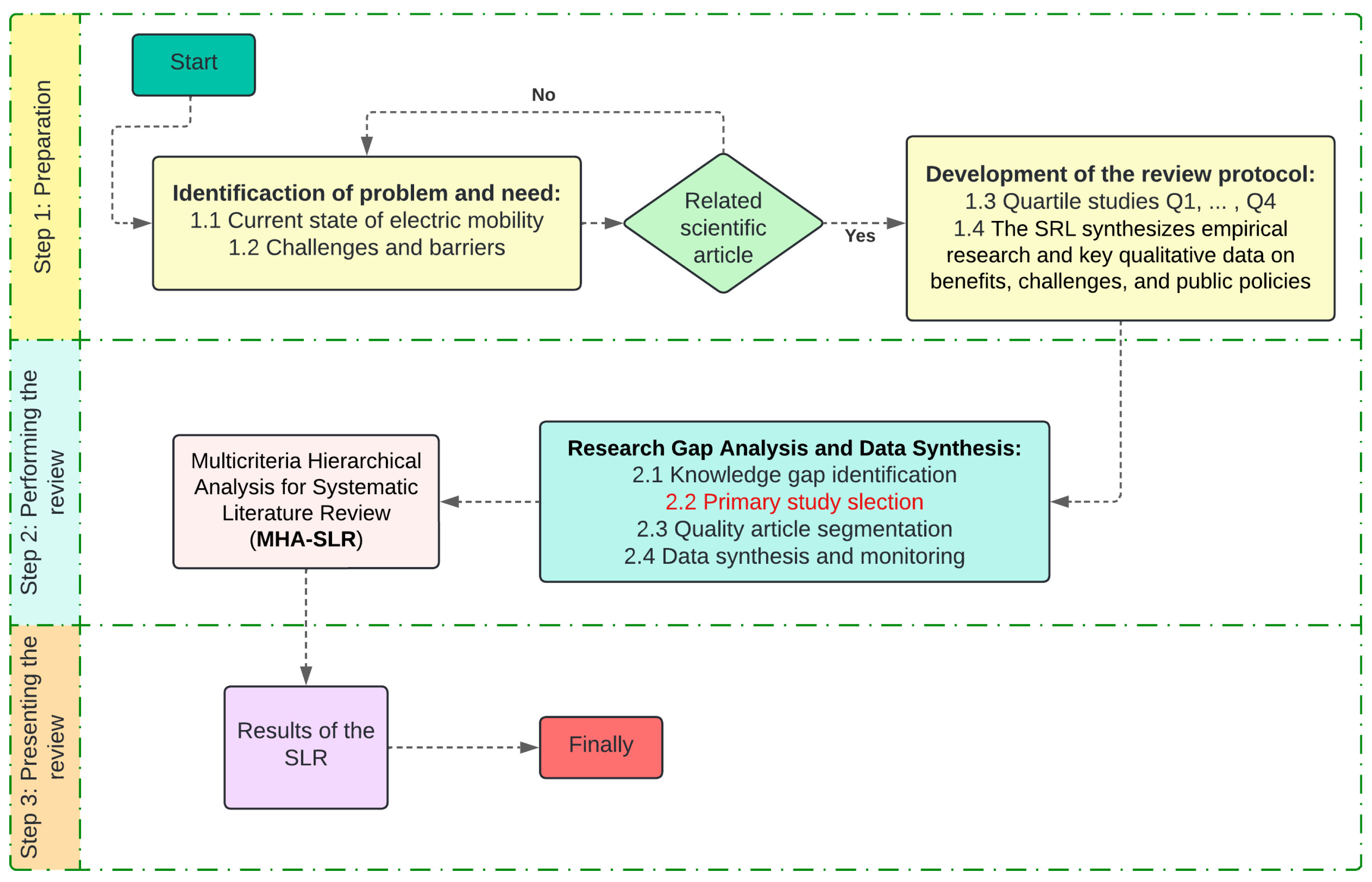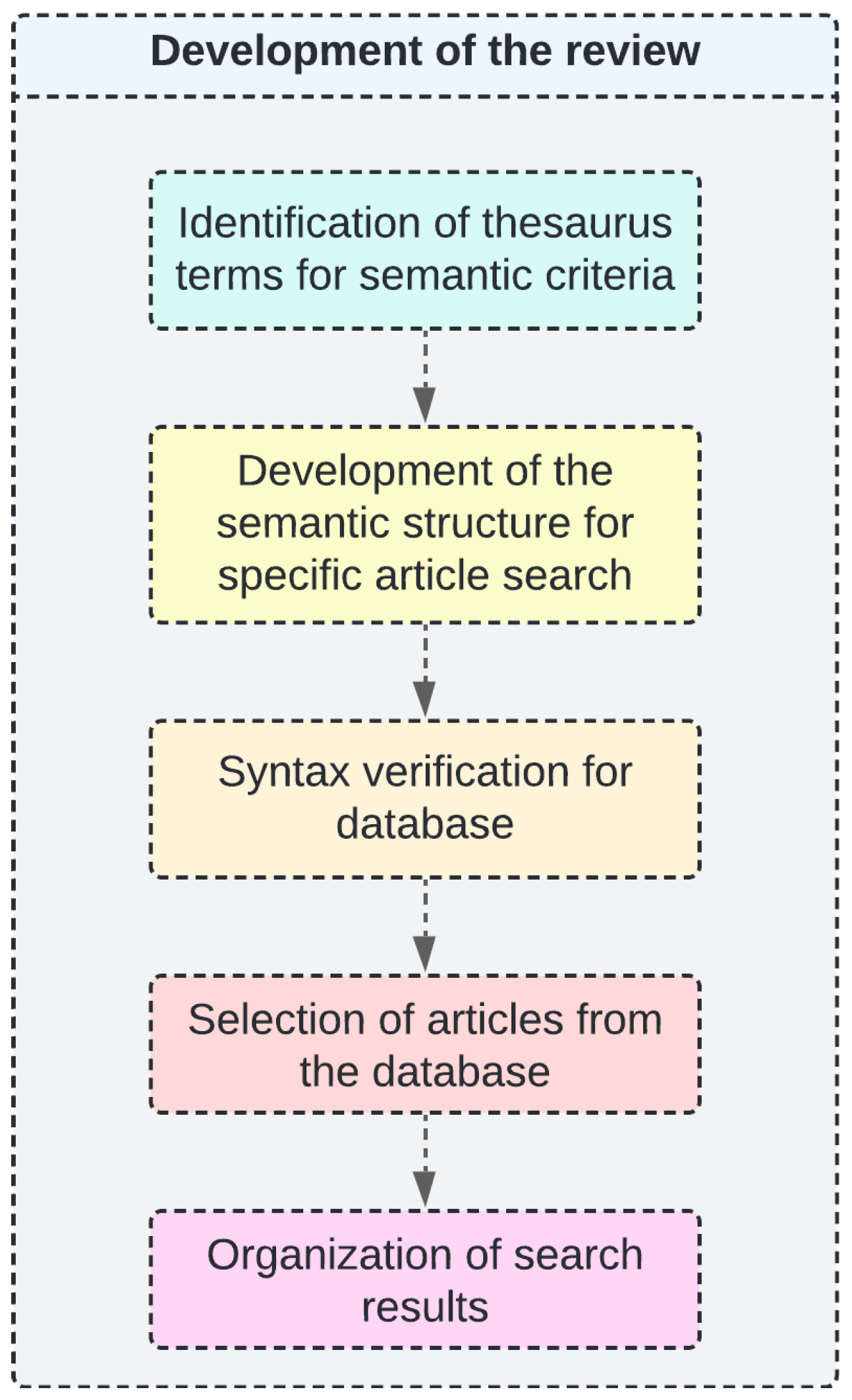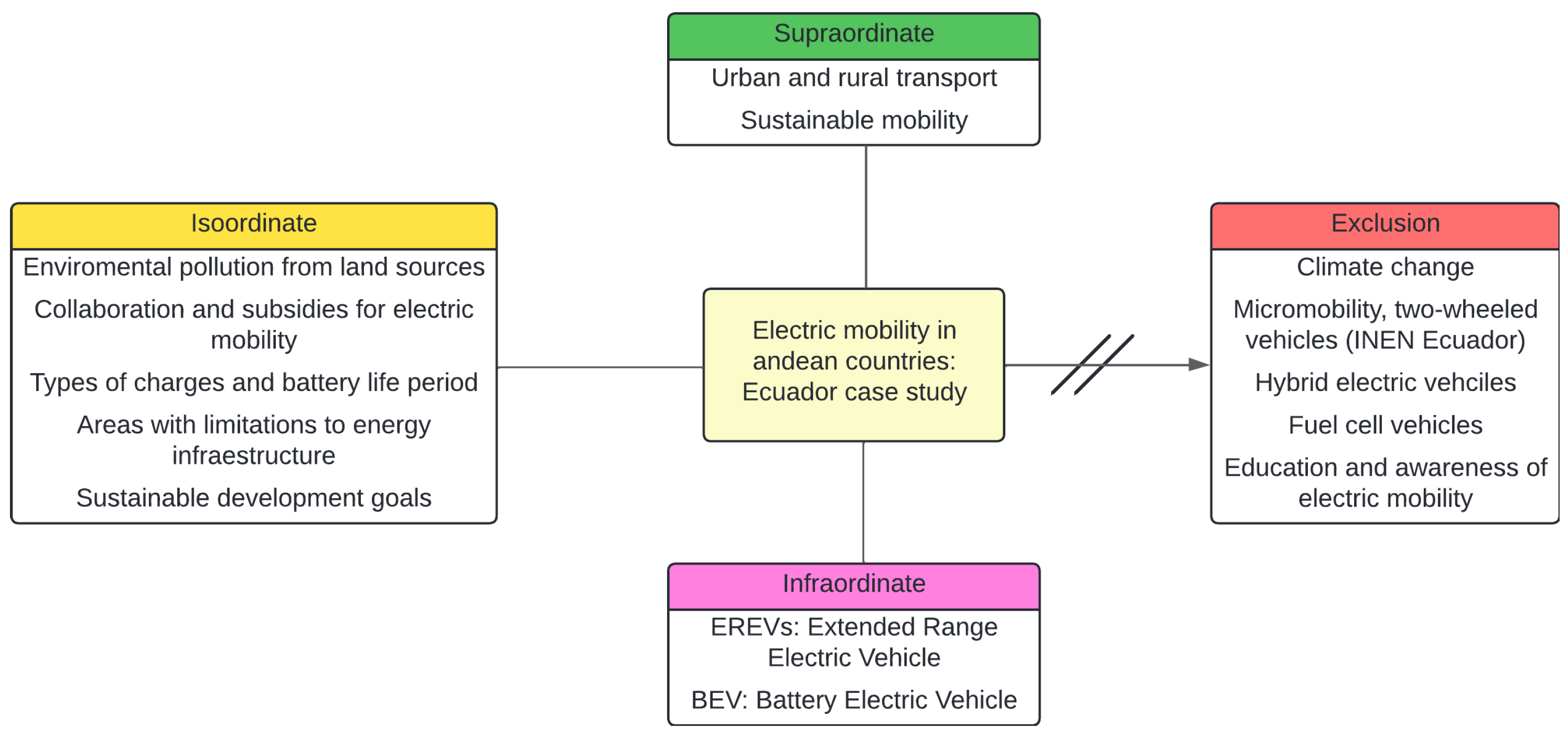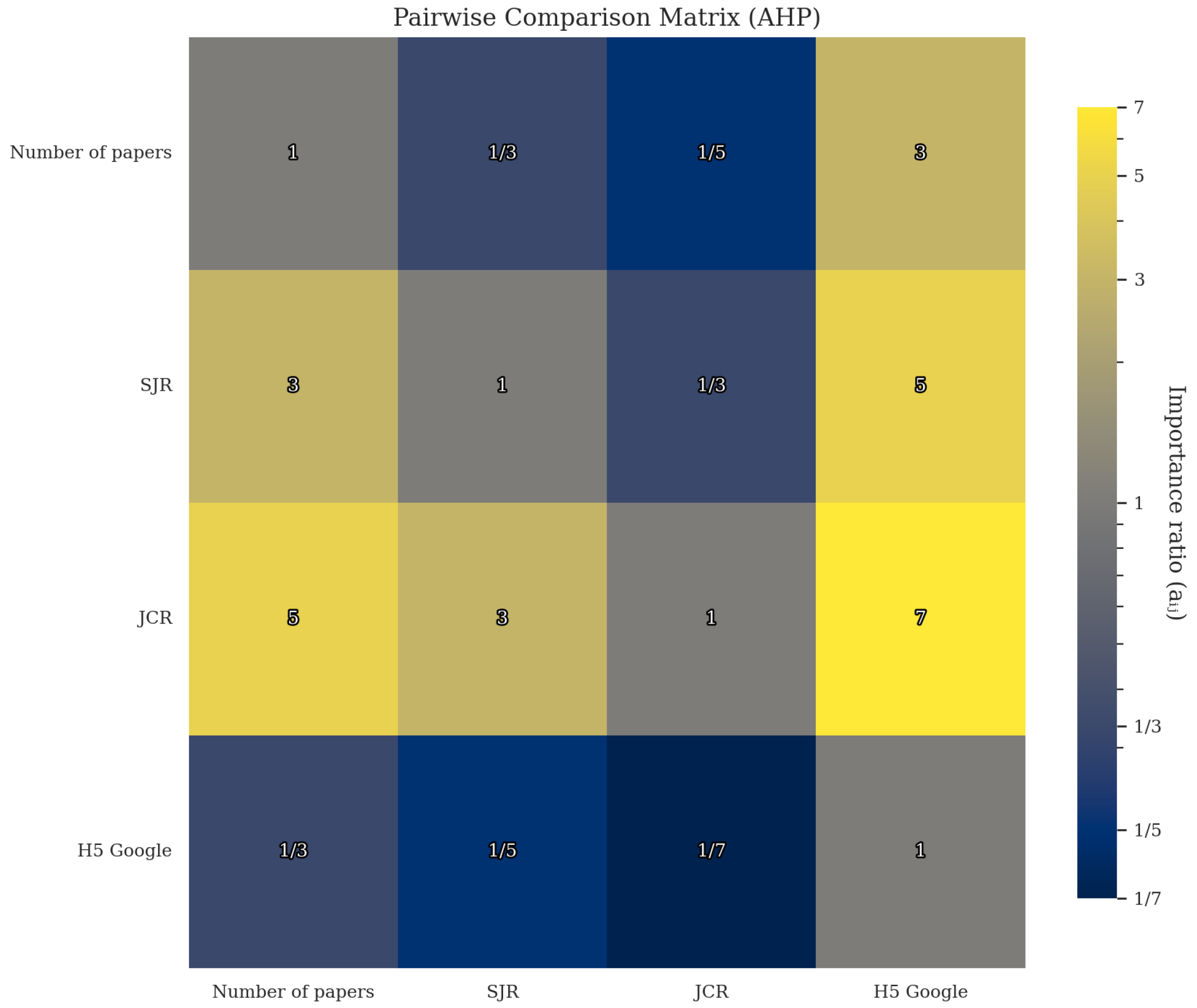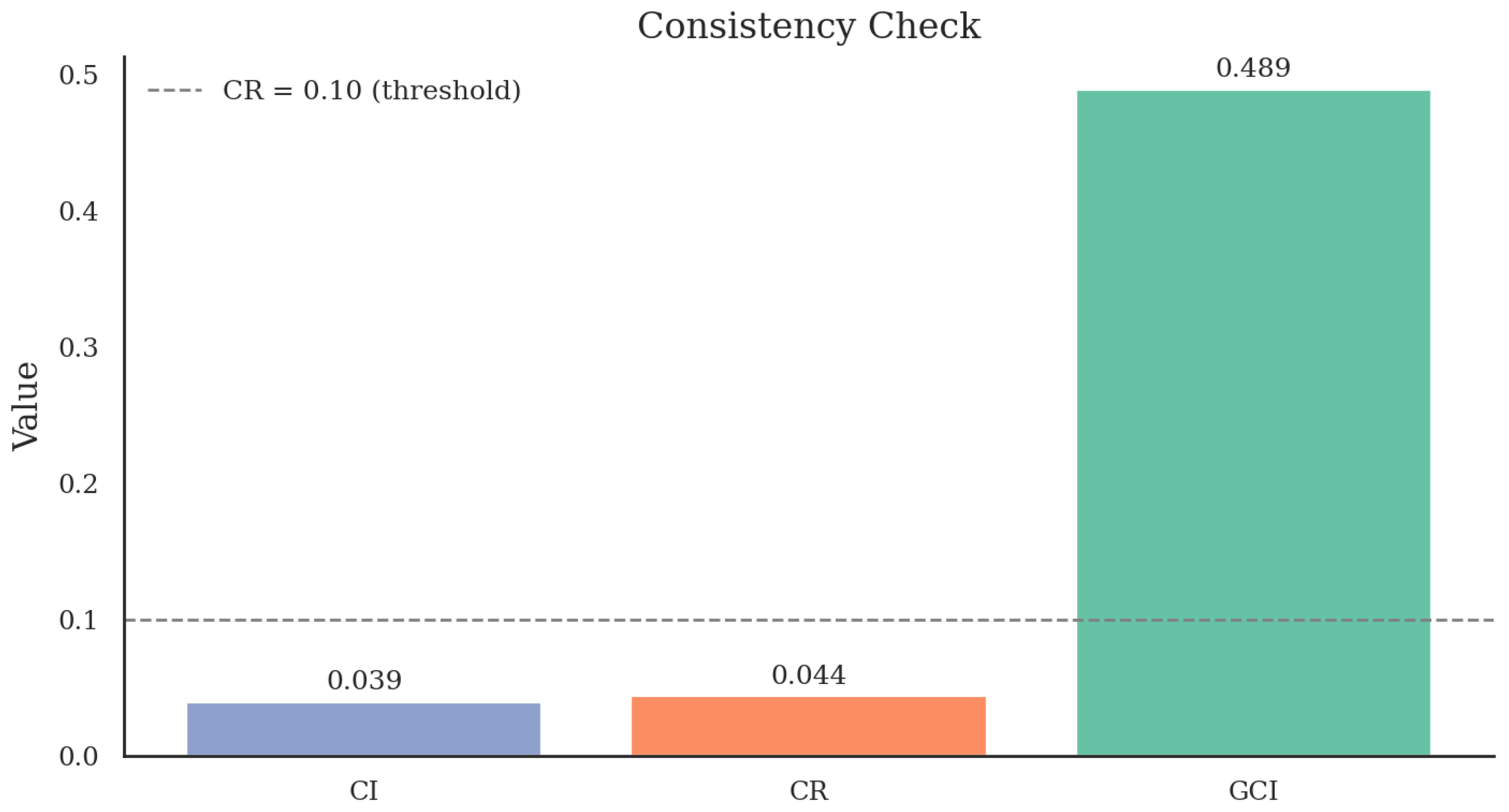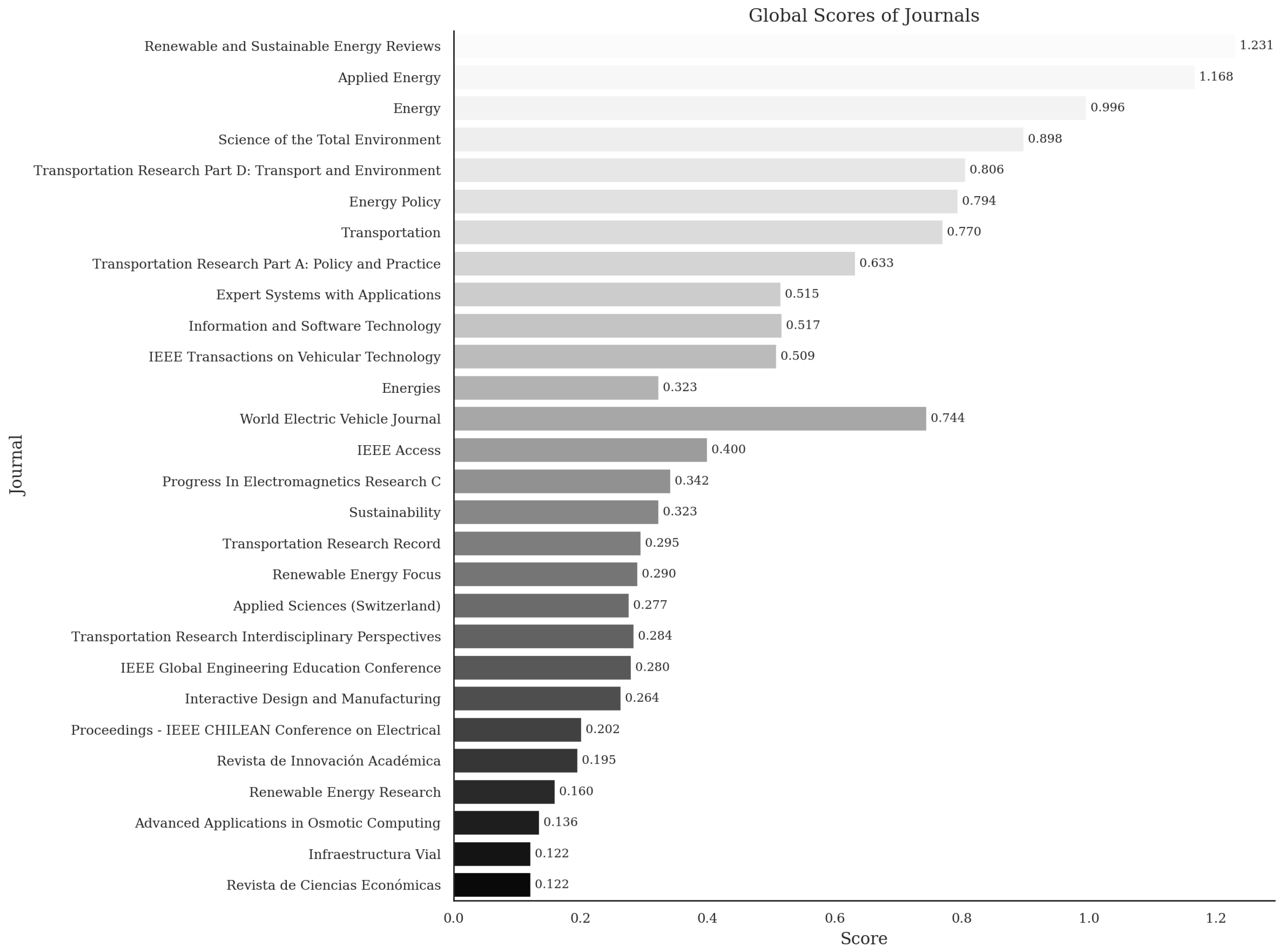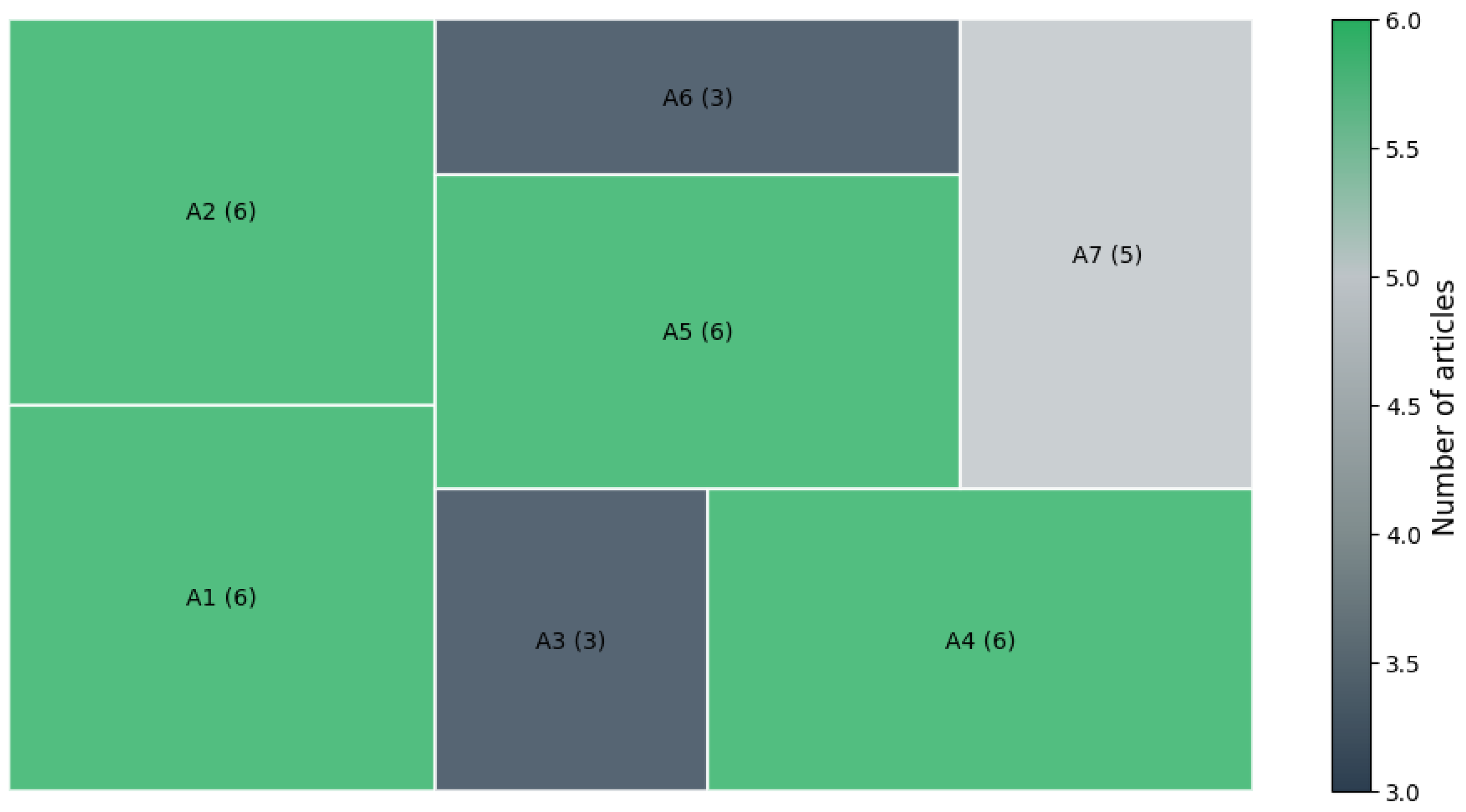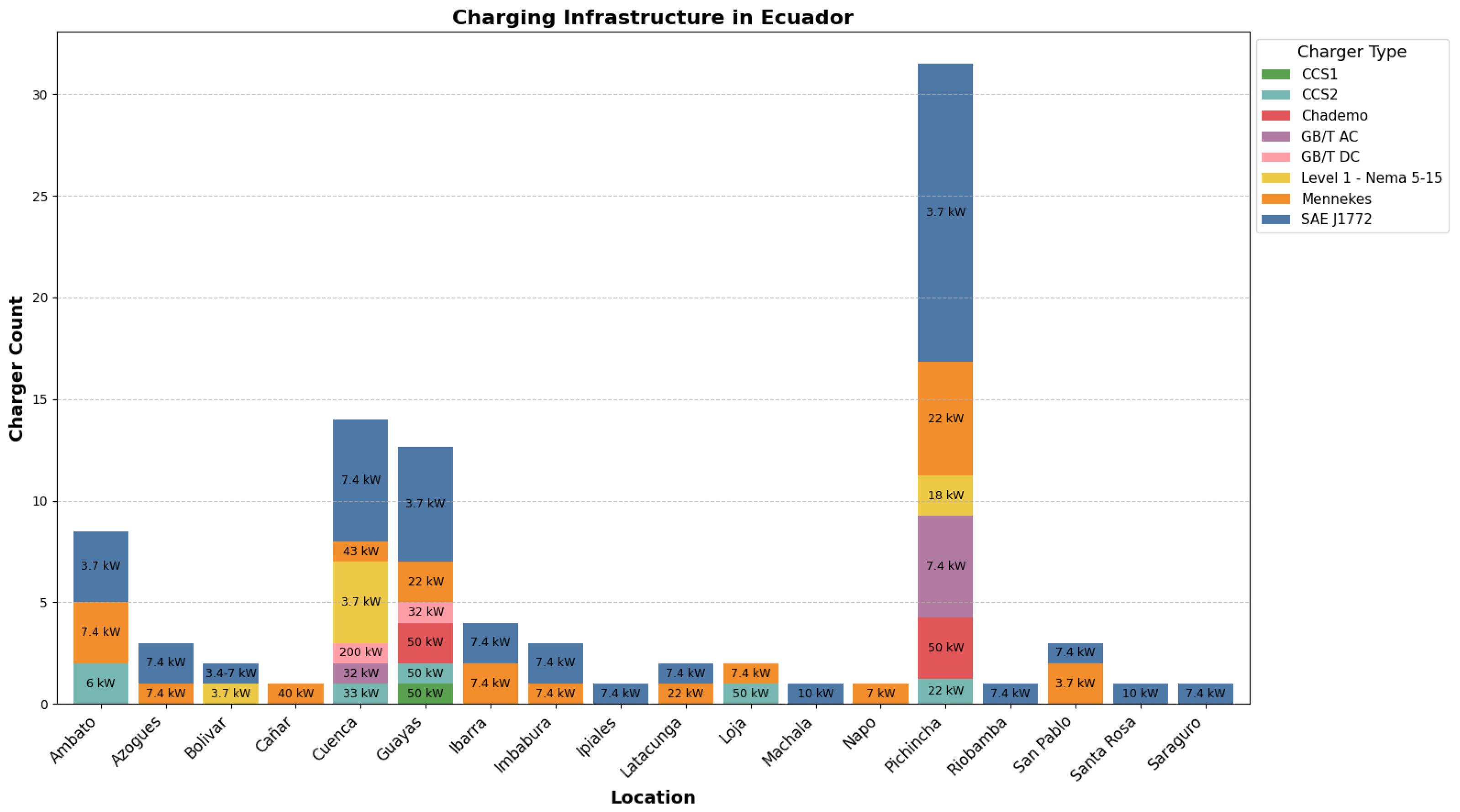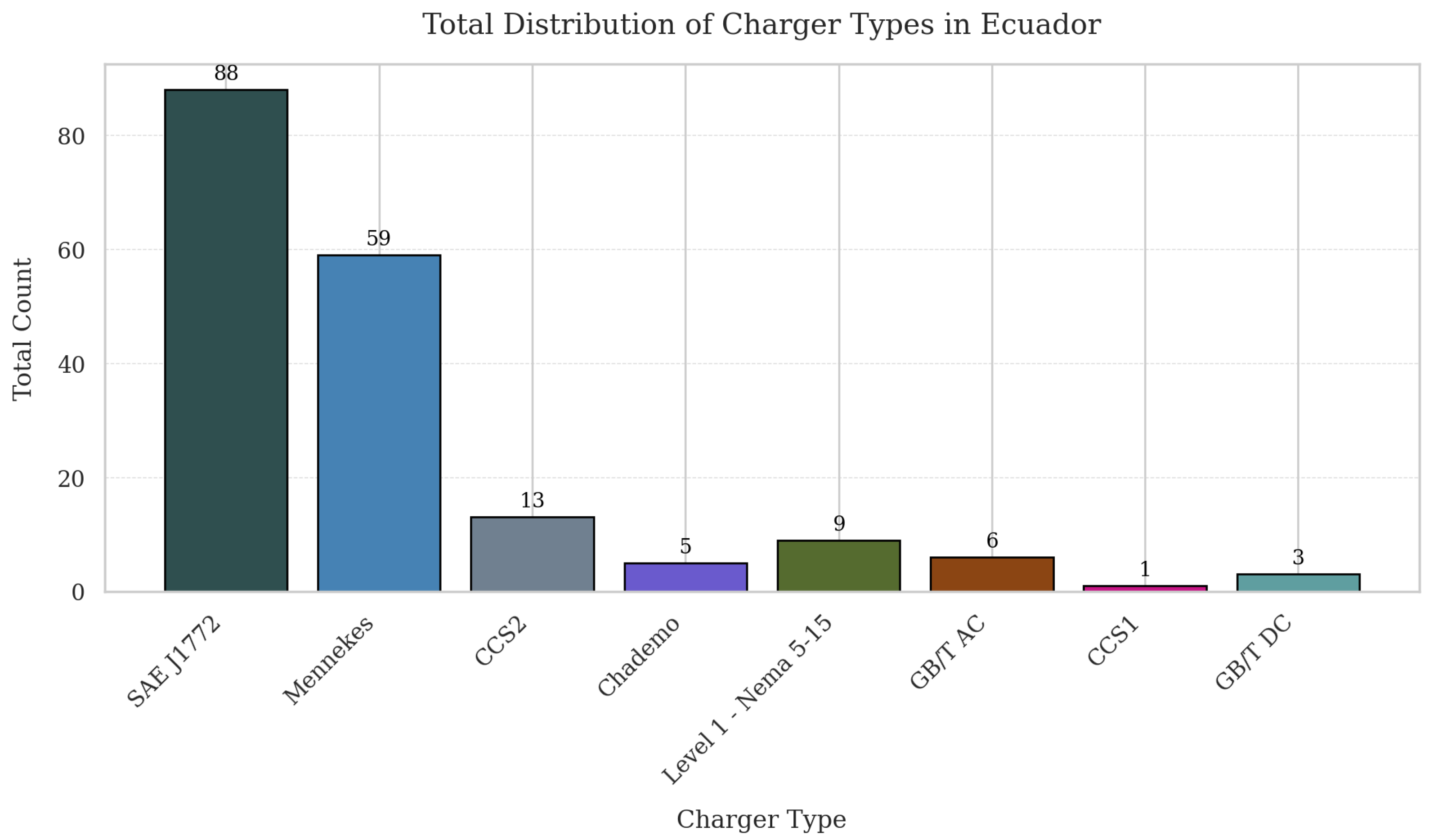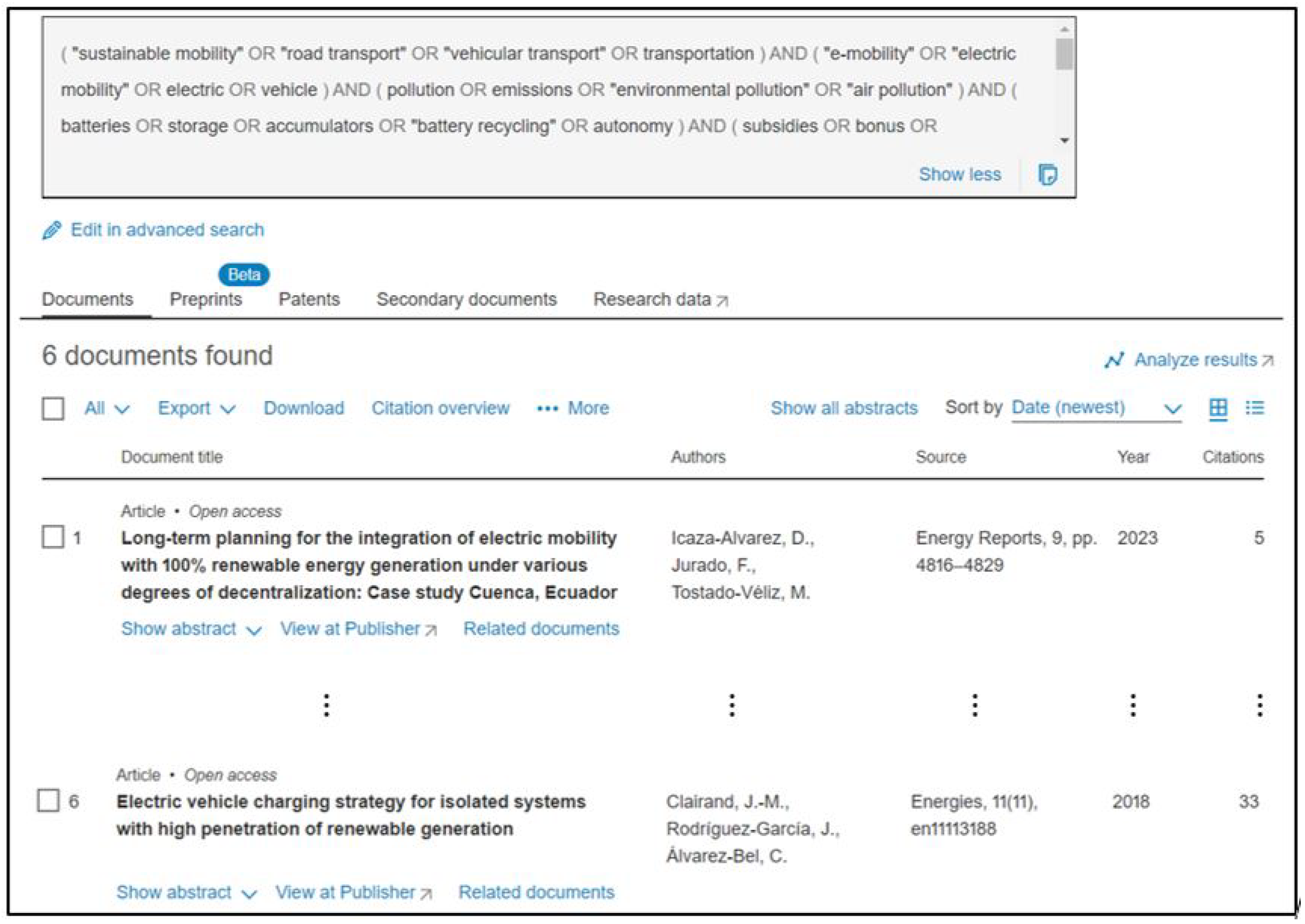1. Introduction
To mitigate the effects associated with environmental degradation and energy issues, the development of electric mobility systems is promoted as an alternative to mass transportation in urban and rural areas across various cities worldwide. In Andean countries, particularly in Ecuador, the implementation of electric vehicles (EVs) helps reduce dependence on fossil fuels and lower the factors associated with pollutant emissions from land transport systems. In developing countries, the transportation sector is one of the main economic activities due to the mobility of people and goods, as well as the connection of trade between different communities, providing access to basic and essential services [
1,
2].
Transportation is one of the major consumers of fossil fuels and generators of CO
2, NOx, and particulate matter emissions released into the environment, which drives local governments towards sustainable mobility solutions [
3,
4]. Various studies identify the transport sector in Latin America and the Caribbean as one of the main sources of greenhouse gas (GHG) emissions, accounting for up to one-third of total emissions [
5]. Of the regional population, 80% is concentrated in urban areas, with a projected increase of 10% by 2050, which will lead to higher transportation demand and GHG emissions if traditional fuels continue to be used [
6].
The products resulting from incomplete combustion processes in internal combustion engines significantly impact air quality and climate change [
7]. Conventional transportation is attributed to causing various health-related issues and environmental effects; the adoption of electric propulsion systems could positively impact these problems [
8]. This implies the demand for in-depth knowledge on sustainable mobility topics and the implementation of electric vehicle systems that operate with renewable energy sources [
2,
9]. The analysis and exploration of sustainable alternatives will reduce dependence on petroleum, while simultaneously promoting a more environmentally friendly mobility [
10].
In Mexico, a model for research and innovation in sustainable urban mobility has been implemented, which includes the establishment of bike lanes and improvements to sustainable public transportation [
11,
12]. Despite these efforts, air pollution still shows significant increases, and although electric taxis have been introduced for public service, the reduction in greenhouse gas emissions has been negligible [
3,
13]. This underscores the need to develop more sustainable mass transit systems for the community [
14].
In Andean countries, such as Chile, the transportation sector was the second-largest emitter of CO
2 from 2018 to 2020. This increase is primarily attributed to the rapid growth of the automotive industry and the use of traditional transportation systems. Local governments are betting on the electrification of public transport, which includes taxis, buses, and minibuses. On the other hand, users are concerned about performance issues when comparing vehicles with internal combustion engines to those powered by electric motors. For electric vehicles, there is a need to establish monitoring systems that can preventatively identify the battery’s lifespan under real operational conditions and assess the autonomy affected by altitude. Associated with these challenges is the high initial cost of acquiring electric vehicles, which is inaccessible to average-income families in countries like Chile and the rest of the Andean region [
15,
16,
17].
Colombia has implemented EVs thanks to incentives and regulations, with the aim of reducing dependency on fossil fuels. However, factors such as range and purchase costs continue to pose significant challenges for society. Battery-powered vehicles are an efficient alternative to traditional vehicles, focusing on uniting efforts aimed at raising awareness about global pollution caused by terrestrial mobile sources [
18,
19].
In the case of Ecuador, electric mobility must be considered for its environmental benefits, as well as its economic and social advantages. By 2021, the transport sector was responsible for 37% of CO
2 emissions [
20], an alarming figure that underscores the need to adopt more environmentally friendly technologies. Consequently, studies have been conducted aimed at the adoption of electric vehicles and the design of charging stations powered by photovoltaic energy [
21].
Cities are expanding their urban boundaries and increasing the use and decentralization of solar and wind energy, while electrifying their transportation systems. Comprehensive city planning and coordination between the public and private sectors are essential for a successful transition to electric mobility [
9]. Furthermore, reducing dependence on fossil fuels can enhance the country’s energy security and lower the costs associated with oil imports [
22].
In Ecuadorian cities such as Ambato and Cuenca, studies were conducted to compare the range of conventional vehicles with electric ones, considering the altitude profile of some cities in the country and the implications of the initial cost of electric buses compared to conventional ones [
23,
24]. The studies highlight the need to introduce fast-charging stations, which would increase the adoption of EVs in the Latin American market. It is estimated that this measure could achieve approximate reductions of 10 kg of CO
2 per day for each EV introduced into the vehicle fleet [
4].
Andean countries should prioritize investment in hydrogen production and the capacity for wind and solar energy in response to the energy crisis each country may face as an alternative [
25,
26]. Brazil, Chile, Colombia, Mexico, and Peru are focused on lithium extraction for battery manufacturing, despite the industrial challenges and technological limitations this entails [
27]. The high solar radiation in Latin American countries presents a significant opportunity to recharge batteries through solar charging stations, thereby reducing the carbon footprint. It is noted that the adaptation of charging infrastructures presents network stability issues if the energy source is from solar panels [
28,
29].
However, despite these benefits, the adoption of electric vehicles (EVs) in Ecuador and Latin America faces several challenges. One of the main challenges is the high initial cost of EVs compared to internal combustion engine vehicles. Although the operational and maintenance costs of EVs are generally lower, which denotes a good medium-term investment from an economic perspective, this advantage is not enough to overcome the initial acquisition barriers [
4]. Furthermore, the lack of adequate and strategically distributed charging stations limits EV adoption, discouraging potential users. The energy crisis in Ecuador amounts to a deficit of 1000 megawatts per day, compared to an average consumption of 4750 megawatts [
30].
The most significant challenges limiting the growth of electric vehicles (EVs), both in the private and public sectors, are the lack of robust public policies and adequate economic incentives to promote EV adoption. Although some countries have implemented tax exemptions, subsidies, and other financial incentives to encourage EV purchases, Ecuador still needs to develop and implement similar large-scale measures [
9]. Public policies play a crucial role in creating a favorable environment for electric mobility by providing economic and regulatory incentives that facilitate the integration of EVs into the conventional transportation system. The implementation of public policies not only incentivizes EV acquisition but also significantly contributes to reducing pollutant emissions, aligning with international commitments to sustainability and combating climate change [
31,
32].
Public policies should prioritize the promotion of research and development (R + D) in electric mobility technologies. This includes funding innovation projects and fostering collaboration between universities, the private sector, and the government, with the goal of facilitating technology transfer [
32]. The implementation of regulations standardizing the charging infrastructure and technical requirements for EVs is essential to ensure efficient and effective integration into the national transportation system [
27,
33].
The objective of this study is to analyze the current situation of electric mobility in Ecuador, identifying both the facilitating factors and the challenges to its development. Through a systematic literature review and a detailed data analysis, the study aims to provide a comprehensive view of the benefits and challenges inherent in electric mobility within the Ecuadorian context. The study also seeks to develop evidence-based recommendations to optimize the existing infrastructure, adjust public policies, and strengthen economic incentives. The recommendations are intended to promote an effective transition towards sustainable electric mobility in Ecuador.
Finally, the paper is structured into five sections: Introduction (
Section 1), Methodology (
Section 2), Review Report (
Section 3), Conclusions (
Section 4), and Research Prospects (
Section 5). In
Section 1, a global overview of electric mobility in Andean countries is provided, with a special focus on Ecuador, aiming to offer a current analysis of the situation in the country.
Section 2 describes the techniques and approaches used for data collection and analysis, as well as the criteria for selecting the reviewed literature.
Section 3 presents the key findings of the study and interprets the results in the context of current policies and practices in Ecuador.
Section 4 summarizes the main points of the study and provides recommendations for future research and implementation actions. Finally,
Section 5 outlines future research prospects and discusses the political issues, challenges, and benefits of electric mobility.
2. Methodology
In this study, the method developed by Kitchenham, adapted for systematic literature reviews [
34,
35], is used and later adapted to define the level of importance using the Analytic Hierarchy Process (AHP) [
36,
37]. Kitchenham’s SLR process was selected because it is widely adopted in engineering and computing studies; it structures the review into preparation, review execution, and reporting, aligning with our research context. The systematic literature review (SLR) methodology proposed by Barbara Kitchenham consists of three fundamental stages that guide the research process as illustrated in
Figure 1. In Stage 1: Preparation, an exhaustive identification of the problems and needs associated with electric mobility is conducted, starting with an analysis of the current state and the challenges involved. This phase includes the development of a review protocol that categorizes articles into different quartiles (Q1 to Q4), facilitating the collection of essential qualitative data regarding the benefits, challenges, and relevant public policies. The inclusion of a conditional check to assess the existence of related articles strengthens the validity of the adopted approach. In Stage 2: Performing the Review, the data are synthesized, and the search process is analyzed to identify gaps in knowledge, while also performing a primary selection of studies through hierarchical process analysis. This process is complemented by an evaluation of the quality of the selected articles and continuous monitoring to ensure data integrity. Finally, in Stage 3: Presenting the Review, the results of the SLR are presented, highlighting implications for future research. This methodical and rigorous approach not only provides a solid foundation for understanding electric mobility but also opens new avenues for academic research and the formulation of effective policies in this emerging field.
The systematic search process consists of sub-stages, which describe Step 2 of the proposed methodology. In
Figure 2, the procedure begins with a set of search terms derived from the conceptual framework and the applied scientific thesaurus for the identification of research works contributing to this study.
Subsequently, a semantic search structure and a specific script tailored to the high-impact journal database are developed. A detailed process of study selection is then conducted, culminating in a search results list as the outcome variable of the procedure.
2.1. Assessing the Need for a Literature Review
In the last decade, electric mobility has experienced exponential growth, driven by research focusing on various aspects such as vehicle range, charging infrastructure, batteries, pollutant emissions, and new sustainable mobility models. In this context, it is essential to identify and analyze the benefits, challenges, incentives, and public policies that promote a transition to sustainable mobility. This approach is particularly relevant for reducing emissions caused by combustion engines in Andean regions, with a special emphasis on Ecuador.
In response to growing concerns about environmental pollution and significant climate changes, a comprehensive review was conducted of high-impact scientific literature (Q1,…, Q4) to identify current benefits of electric mobility. This review included a detailed analysis of the challenges associated with the geographical infrastructure, the range of new battery technologies, and government incentives and commitments aimed at promoting the development of electric transportation. Current environmental regulations and implemented national strategies were examined to contribute to the Sustainable Development Goals (SDGs). Specifically, the review addressed SDG 7 (Affordable and Clean Energy), SDG 11 (Sustainable Cities and Communities), and SDG 13 (Climate Action) due to the systematic nature of the review.
2.2. Evaluating the Necessity of a Literature Review
One of the most critical activities in the protocol of a systematic literature review (SLR) is the formulation of research questions. These questions must address societal issues from a scientific perspective, enabling the evaluation of the relevant elements, relationships, and concepts in each section of the research. To guide the topic and the area of interest related to electric mobility, the following research questions were developed:
RQ1: What are the current benefits applied to the transition to electric transportation in Andean countries, with a special focus on Ecuador?
RQ2: What are the latest challenges in the transition to electric mobility?
RQ3: What are the current public policies promoting a transition to electric transportation?
2.3. Theoretical Framework Map
The conceptual mind map presented here has been designed as a hierarchical diagram aimed at organizing fundamental ideas and filtering out less relevant ones from the literature review as illustrated in
Figure 3. This framework has been structured to enable the assimilation of a complex idea and its conceptualization as follows:
Superordinate: At this level, the central concept of the study is defined, focusing on electric mobility and sustainable transportation through the use of electric vehicles in Andean regions, with a particular emphasis on Ecuador.
Iso-ordinate: This highlights the links and relationships between adjacent propositions, connecting ideas together. These connections ultimately serve as the keywords used in the search for scientific literature, aimed at defining the characteristics of the central concept of electric mobility.
Exclusions: This section outlines the categories that either oppose or are excluded from the central concept, and which differ from an operational perspective. Examples include hybrid vehicles or micromobility solutions.
Infraorder: This contains two subclasses or derivations that encompass the main components of electric mobility or sustainable mobility.
2.4. Comprehensive Overview of Systematic Reviews
Table 1 presents the semantic structure established by levels according to the conceptual framework. Additionally, a search script is developed, as detailed in
Table 2, which facilitates the exploration of scientific literature in high-impact journals. By utilizing the conceptual diagram and relying on thesauri and controlled vocabularies, the efficient search for scientific information is optimized through the use of standardized terms.
The five levels of the search script are designed to directly address the research questions. They begin with the topic of sustainable mobility and progress to areas such as electric mobility, environmental pollution, battery recycling, incentives, and public policies, as well as the charging infrastructure and electrical grids. Finally, they focus on the Andean region, with a particular emphasis on Ecuador. This structured approach enables the more effective identification and collection of the relevant scientific literature, employing exclusion criteria that limit the search to studies published between 2019 and 2024, and focusing on scientific articles and literature reviews.
Table 2 presents the search script used in this systematic review, which was developed based on a conceptual framework to structure the search for relevant literature in a rigorous and consistent manner aligned with the research questions. This script combines key terms and logical operators (AND/OR) to comprehensively address the main aspects of sustainable and electric mobility in Latin America, with a focus on Ecuador. The search terms are grouped into essential categories such as sustainable mobility and transport (e.g., “sustainable mobility” and “road transport”), electric mobility (e.g., “electric vehicle” and “e-mobility”), environmental impact (e.g., “pollution” and “emissions”), battery storage and recycling (e.g., “batteries” and “battery recycling”), government policies (e.g., “subsidies” and “government policies”), and the necessary energy infrastructure (e.g., “power grid” and “energy network”). Geographical filters limit the results to Latin American countries (Ecuador, Chile, Colombia, and Venezuela), and a publication range between 2019 and 2025 is set to ensure the relevance of the studies. Additionally, filters specify document types (research articles and reviews), ensuring the precise selection of the pertinent literature. This methodological approach guarantees comprehensive coverage and a rigorous selection of the relevant literature, aligned with the objectives of the systematic review, providing a solid foundation for analyzing the challenges and opportunities in the transition to electric mobility in the region.
Following the application of the search script detailed in
Table 2, the systematic review identified only six relevant studies as illustrated in
Figure 4. These studies, sourced from Scopus and listed as SLRs [
9,
38,
39,
40,
41,
42], are described as follows.
In Chile, a study has been conducted that, as mentioned in [
38], implements an algorithm based on the K-means clustering method. This approach optimizes the minimization of annual aggregated costs and underscores the importance of reducing dependence on fossil fuel-based electricity generation, while promoting the integration of renewable energy sources into the power grid. Furthermore, the study incorporates an expansion plan for the national electrical system. It also highlights how governmental support in developing a public charging infrastructure network positions Chile as a leader in the adoption of sustainable mobility compared to other countries in Latin America.
Studies conducted in the city of Cuenca, referenced in [
9,
39], focus on advancing sustainable mobility through the adoption of electric vehicles. The work by [
9] proposes a roadmap for the energy transition in the transportation sector, emphasizing the utilization of renewable energies such as wind and solar power.
In a complementary approach, Ref. [
39] emphasizes the importance of electrifying public transportation, specifically electric buses (EBs), with the goal of reducing diesel consumption by up to 83%. These initiatives align with Ecuador’s Organic Law on Energy Efficiency, which establishes clear targets for the transition to electric mobility. According to this law, effective since 2019, all vehicles in the country are mandated to be 100% electric by the year 2025. Furthermore, the law introduces a range of benefits and incentives, including tax exemptions and preferential financing, to promote the adoption of clean technologies in the transportation sector. The public policies outlined in this regulation aim not only to reduce pollutant emissions but also to position Ecuador as a leader in sustainable mobility within the Latin American region.
The review by [
40] presents the ELENA model, a framework for analyzing land and energy use in Ecuador aimed at supporting a decarbonization strategy for 2050. This model forecasts that 70% of buses and 33% of private cars in Ecuador will operate on electric energy. Additionally, Ref. [
41] estimates that by the same year, the adoption of electric vehicles in Ecuador will reach 30%, 50%, and 80% under conservative, expected, and optimistic scenarios, respectively. Furthermore, Ref. [
42] emphasizes the importance of implementing a smart charging methodology for electric vehicles in Galápagos to mitigate environmental impact.
Table 3 presents a comprehensive summary of the principal findings and limitations related to the research questions (RQs) investigated in this study. The table delineates the advantages, challenges, and public policies associated with the transition to electric vehicles as identified in the reviewed literature. Specifically, the examined articles underscore various benefits, including reduced CO
2 emissions and enhanced air quality; however, they do not comprehensively address all the research questions. Notable challenges include insufficient charging infrastructure and high initial costs, while the public policies discussed encompass tax incentives and infrastructure investments. The identified gaps highlight the significance of our systematic literature review (SLR), which aims to rectify these deficiencies and provide a more thorough understanding of the electric vehicle transition.
2.5. Establishment of Criteria for Study Selection and Exclusion
The inclusion criteria for compiling references in this table are based on studies that directly address the benefits, challenges, and public policies related to the transition to electric transportation. This includes empirical research, literature reviews, and policy analyses that provide relevant quantitative or qualitative data. Exclusion criteria remove studies that lack a focused analysis on electric mobility or concentrate on technologies not pertinent to vehicular transition, such as micromobility, hybrid vehicles, climate change impacts, two-wheeled vehicle mobility, and fuel cell technologies, as well as educational and awareness efforts in electric mobility, and research on renewable energies not directly related to transportation.
2.6. Category Classification
The categories outlined in this table are organized into three principal areas that address different aspects of the transition to electric transportation. Firstly, RQ1: Benefits of the Transition to Electric Transportation highlights the positive impacts quantified by Ecuador’s “Organic Law of Energy Efficiency”, which includes a target to reduce energy consumption by 10% by 2030 and a projected decrease of 5 million tons of CO
2 equivalent. This category also addresses improvements in air quality, increased energy efficiency, and job creation, supported by subsidies of up to 20% for efficient technologies. Secondly, RQ2: Current Challenges in Electric Mobility focuses on barriers such as insufficient charging infrastructure, with a forecasted USD 50 million investment for 2023 to 2028, with the high initial costs of electric vehicles, battery life issues, and range limitations still posing significant hurdles. Lastly, RQ3: Public Policies for Promoting the Transition to Electric Transportation examines the existing policies including fiscal incentives and emission regulations. The law aims for 50% of the national energy to come from renewable sources by 2040 and allocates specific funds to support energy efficiency projects. These categories provide a comprehensive analysis of the benefits, challenges, and policies influencing the shift towards a more sustainable and efficient electric transportation system [
44,
45].
2.7. Journal Selection Criteria
Table 4 presents a list of journals that have significantly contributed to the research. It details key metrics such as the Impact Factor (IF) and quartile rankings according to the Journal Citation Report (JCR) and Scimago Journal Rank (SJR), as well as the h5 index value from Google Scholar. Additionally, the table specifies the number of articles reviewed from each journal.
The prioritization of journals is determined using the Analytic Hierarchy Process (AHP), based on evaluative criteria [
46]. This process involves a set of journals denoted as
, which are assessed according to
n criteria,
. Each criterion represents different evaluation metrics:
corresponds to the number of reviewed articles,
to the JCR index,
to the SJR index, and
to Google’s h5 index. Each criterion is assigned a specific weight
reflecting the relative importance of the journal [
9]. The relative weights of each criterion are constructed from the pairwise comparison matrix
, where each element
represents the relative importance of criterion
over criterion
[
47]. This systematic evaluation framework allows for a thorough assessment of how each criterion influences journal ranking.
To further elucidate the relative significance among the four evaluated criteria, a detailed pairwise comparison matrix was designed as illustrated in
Figure 5. This matrix was constructed using a preference scale, where values of
and 9 indicate equal, moderate, strong, very strong, and extreme importance, respectively, among the criteria being compared [
46]. In addition to these direct comparisons, inverse values (such as
etc.) were incorporated to express the lesser importance of one criterion compared to another. Given its substantial weight in the evaluation, the JCR index was prioritized in this analysis, receiving scores of 3 when compared to the SJR, 5 against the number of articles, and 7 in relation to the h5 index, clearly indicating a structured hierarchy in the perceived relevance of these criteria. The resulting analysis assigned relative weights to each criterion: number of articles
, SJR
, JCR
, and h5 index
. The finally, the values along the main diagonal are all equal to one, indicating that each criterion has the same importance when compared to itself. The colors in the matrix represent the intensity of preference: red and orange tones indicate a higher relative importance of one criterion over another, such as the JCR compared to the others, as evidenced by values like 5.00 and 7.00. In contrast, light blue tones represent moderate importance, while dark blue tones correspond to lower values, such as 0.33 or 0.20, suggesting a lower priority of certain criteria in comparison to others.
To ensure the validity of these comparisons, the consistency index (CI) and Geometric Consistency Index (GCI) were calculated, yielding a Consistency Ratio (CR) of . This ratio, being below the acceptable threshold of , confirms the consistency and reliability of the derived weights, thereby reinforcing the robustness of the AHP process in the hierarchical classification of the selected criteria.
Each element
of the matrix is normalized by dividing each element of the matrix by the sum of the elements in its respective column, thereby obtaining a matrix of normalized proportions as indicated in Equation (
1):
The relative weights of the criteria
are defined as the average of each row of the normalized matrix, where
refers to the elements of the normalized matrix, and
n denotes the number of criteria in Equation (
2):
In the proposed hierarchical analysis methodology, the priority vector is defined as the product of the pairwise comparison matrix and the vector of relative weights:
The maximum eigenvalues
of the pairwise comparison matrix, which represent the consistency of the judgments in the matrix, are defined as follows:
For the evaluation of the alternatives, the Consistency Index
and the Consistency Ratio
are defined, which depend on a standard value
that reflects the randomness resulting from the size of the matrix. For
, the standard value is
[
47]:
The overall scores
for the various journals are computed as a linear combination of the normalized criteria, weighted by their respective importance factors:
The Geometric Consistency Index
is applied to measure the consistency of triangular judgments within the matrix. For a triplet
, the geometric product
is defined, with
being defined in Equation (
7), where
m represents the number of possible triplets [
47]:
In
Figure 6, the consistency diagnostics (CI, CR, and GCI). The figure reports the Consistency Index (CI), the Consistency Ratio (CR), and the Geometric Consistency Index (GCI) for the pairwise-comparison matrix. Following standard practice, CR < 0.10 indicates acceptable and reliable consistency. The GCI used here (as defined previously) evaluates the average absolute deviation of each triad’s multiplicative consistency from unity; values near zero denote negligible geometric inconsistency among triads, whereas larger values indicate greater departures from transitivity [
47].
In
Figure 7, a composite measure is presented that reflects the overall assessment of each journal based on the weighted criteria and their respective weights. A high overall score indicates superior relative performance across the evaluated criteria. This metric facilitates the prioritization of journals within the context of the proposed research by identifying those that are most relevant and impactful. The colors reflect the relative relevance of the journals: dark blue tones represent those with the highest impact, such as “Renewable and Sustainable Energy Reviews” and “Applied Energy”, which stand out for their top scores. Light blue tones indicate a moderate level of importance, with journals like “Transportation Research Part A” and “Energies”, which are significant but do not reach the highest levels. On the other hand, reddish tones identify journals with lower priority, such as “Revista de Innovación Académica” and “Infraestructura Vial”, which show the lowest scores due to a weaker performance across the evaluated criteria.
In
Figure 8, the geometric products of the triads used to evaluate the geometric consistency of the pairwise comparison matrix are depicted. The ideal geometric product of a triad is close to 1. This is because, for perfectly consistent comparisons, the product path among the three criteria should close in a balanced relationship. Deviations from 1 reflect inconsistencies in the comparisons. A
close to 0 indicates that the geometric products of the triads are near 1, signifying that the comparisons are highly consistent [
47].
Table 5 summarizes the weights assigned to different criteria for evaluating journals, showing that the H5 Google index has the highest influence, followed by the SJR Impact Factor, JCR Impact Factor, and Number of Papers. It also presents two key consistency measures: the Consistency Ratio (CR), which indicates potential issues with the consistency of the pairwise comparisons, as it is negative, suggesting that the comparisons may be unreliable, and the Geometric Consistency Index (GCI), which reflects the overall geometric consistency of the comparisons. With a GCI of 0.4888, it implies that, while there is some level of consistency, further improvements could be made to enhance the reliability of the comparisons.
3. Review Report
A comprehensive review of the literature on electric mobility in Andean countries, with a particular emphasis on the Ecuadorian context, was consolidated into a detailed and structured report. This research relied on the use of analytical tools such as tables and graphs to facilitate the visual representation of the collected data, enabling precise and clear interpretation of the available information. The study addressed a series of fundamental questions, organized around critical categories and variables, such as public policies and the economic and environmental benefits, as well as the technological challenges associated with the transition to electric mobility. Furthermore, a rigorous and thorough process of gathering relevant bibliographic sources was conducted, ensuring the inclusion of recent and high-impact studies within the scientific community, thereby enhancing the robustness and timeliness of the presented findings.
The frequency analysis of key terms and concepts in the selected sources allowed for the identification of significant patterns and trends related to electric mobility in Andean countries, with a particular focus on the Ecuadorian context. According to the findings of Rodriguez et al. [
48], well-structured public policies play a crucial role in promoting and adopting electric mobility technologies. This methodological approach, characterized by its rigor and strong theoretical foundation, not only ensures that the report is informative but also positions it as a valuable reference tool for future research and the development of effective policies in the field of electric mobility [
49,
50].
In the research pertaining to RQ1, high-impact literature sources were reviewed to provide relevant information on environmental pollution, the associated environmental benefits, and local development driven by the adoption of electric mobility. A detailed approach was taken with the search script described in
Table 6, as these studies, conducted in Andean countries, are fundamental for analyzing the direct effects of electric mobility on the reduction in greenhouse gases (GHGs) [
51].
Table 6 presents a synthesis of the benefits identified in the literature, which address RQ1 and are directly related to the transition towards electric transportation in Ecuador and other Andean countries.
In this context, the transition to electric transportation in Andean countries, such as Ecuador, presents significant environmental and economic benefits. Reducing greenhouse gas emissions is crucial for mitigating climate change, and electric vehicles offer a cleaner alternative to conventional fossil fuel-based transportation [
52]. Furthermore, it promotes a reduction in external energy dependence by encouraging the use of locally sourced renewable resources for electricity generation. This transition may also drive technological innovation and create new employment opportunities in sectors related to the manufacturing, maintenance, and distribution of electric vehicles and charging systems [
53].
The results indicate that the implementation of a green tax targeting internal combustion engine vehicles, combined with the RENOVA scrapping plan, could reduce the fleet of internal combustion engine vehicles by 43% by the year 2040 [
54,
55]. Furthermore, another study reveals that the incorporation of electric bus (EB) fleets into public transportation significantly improves air quality, with average monthly reductions of NO
2 by
in the city of Quito [
56].
To mitigate the pollution resulting from both public and private transportation, transitioning to electric vehicles (EVs) is crucial. In this context, several studies [
49,
57] recommend the removal of subsidies for fossil fuels and, instead, advocate for the promotion of economic incentives to support the development and adoption of renewable electric systems, aiming to facilitate this transition [
58].
Table 6.
Articles related to the current benefits applied to the transition to electric transportation in Andean countries.
Table 6.
Articles related to the current benefits applied to the transition to electric transportation in Andean countries.
| Benefits | References | Number of Document |
|---|
| A1: Reduction in CO2 Emissions | [12,18,26,39,42,50,54,57,59] | 9 |
| A2: Enhancement of Air Quality | [11,27,56,60,61] | 5 |
| A3: Reduction of Fossil Fuel Dependence | [49,58,61,62,63] | 5 |
| A4: Energy Efficiency | [1,16,23,43,50,51,53,64,65,66] | 10 |
| A5: Technological Innovation | [3,33,53,61] | 4 |
In
Figure 9, it can be observed that the category with the highest frequency is A4: Energy Efficiency, which appears in 10 of the reviewed articles. This category is followed in frequency by A1: CO
2 Emission Reduction, A2: Air Quality Improvement, and A3: Reduction of Fossil Fuel Dependency, each of which is mentioned in five of the analyzed articles. Lastly, the category A5: Technological Innovation is present in four of the considered studies. This frequency order suggests that energy efficiency is the predominant topic in the consulted literature, whereas the other topics, although relevant, are addressed less frequently in the presented studies.
Electric mobility faces a series of significant challenges that have been extensively discussed in the literature. Among the most notable are the lack of an adequate charging infrastructure and the absence of standardization in charging systems, which hampers their widespread adoption in various regions [
9,
41]. Although these vehicles exhibit lower operating costs compared to their internal combustion counterparts, the high initial cost remains a substantial barrier to greater market penetration. This factor is further exacerbated by the lack of consumer awareness regarding long-term return on investment and the specific maintenance costs associated with electric vehicles [
67]. Additionally, one of the primary concerns among potential users is the limited range offered by these vehicles, a factor that significantly impedes the transition toward more sustainable mobility. This set of barriers underscores the need for coordinated measures to address the technical, economic, and social challenges that slow the adoption of this technology.
When evaluating the total cost of an electric vehicle, it is crucial to consider the cost associated with the battery and its lifespan. According to a study, it is estimated that the battery needs to be replaced approximately every eight years [
19], which represents a significant financial impact over the vehicle’s lifetime. This replacement need, coupled with the limited development in battery technology, has been a key factor affecting market adoption. Current battery capabilities offer restricted range and high initial costs, leading to uncertainty among potential buyers [
49].
In recent years, technological advancements have driven significant investment in the research and optimization of energy storage systems, particularly in the development and refinement of batteries for electric vehicles (EVs). Within this context, recent studies have proposed innovative solutions to enhance the energy efficiency of these vehicles. In this regard, Orsi [
68] suggests the integration of solar panels into EVs as a key strategy, aimed at reducing charging times, decreasing energy consumption from conventional sources, and subsequently lowering associated costs for consumers.
Table 7 summarizes the primary challenges identified in the academic literature regarding the transition to electric mobility in Andean countries, highlighting both the technical and economic as well as social barriers that impede the widespread adoption of this technology. The most frequently cited challenges include an inadequate charging infrastructure and high initial costs, both of which are extensively addressed by six studies, underscoring their critical impact on the implementation of sustainable transportation systems. Additionally, the technological development of batteries and the lack of standardization of chargers present significant obstacles, also supported by six studies, reflecting the need for more advanced and uniform technological solutions in the region. Less explored in the literature, but equally pertinent, are battery lifespan and recycling, with three studies, and range limitations on long trips, with five references, which emerge as critical areas for future research. Collectively, the findings reveal the necessity of a comprehensive approach that combines technical advancements with policies addressing costs and social acceptance to overcome the barriers currently limiting the adoption of electric mobility in these countries.
Figure 10 illustrates the distribution of 35 scientific articles addressing the fundamental challenges in the transition to electric mobility. A chromatic scale ranging from yellow to green is employed, representing the frequency of articles related to each identified challenge. Levels A1, A2, A4, and A5, which correspond to the insufficient charging infrastructure, high initial costs, technological development of batteries, and lack of charger standardization, respectively, are highlighted with six articles each, underscoring the critical relevance of these issues in the reviewed literature. In contrast, challenges related to battery lifespan and recycling (A3) and market and consumer resistance (A6) are less represented, with three articles each, while challenge A7, concerning range limitations on long journeys, is documented in five articles. The variation in block size and color effectively visualizes the relative importance of each challenge within the context of electric mobility, highlighting those that have received the most attention in the recent academic research.
In various Andean countries, such as Chile, legislative initiatives have been implemented to encourage the adoption of electric vehicles (EVs) through measures including financial support, tax exemptions, toll-free access, and the use of free charging stations [
38]. Similarly, in Ecuador, the government has promoted regulations aimed at fostering sustainable mobility, notably, the Organic Law on Energy Efficiency, the Ecological Transition Decree, and the ELENA Policy [
38,
39,
40,
41]. However, these initiatives have not been fully implemented or have faced delays, largely due to limited public acceptance, which has hindered their effective execution. The lack of a favorable public response underscores the need for greater awareness and complementary strategies to facilitate the transition to cleaner technologies in the transportation sector.
The results presented in
Table 8 indicate that the most documented public policies aimed at promoting the transition to electric transportation primarily focus on fiscal incentives. These incentives are widely acknowledged as a key tool for reducing the initial costs of electric vehicles and encouraging their widespread adoption. Additionally, stricter emission regulations are emerging as an effective regulatory approach to accelerate the decarbonization of the transportation sector. While subsidies for research and development are crucial for fostering technological innovation, their lower representation in the literature suggests that they have received less attention compared to direct consumer incentives. Similarly, public awareness programs and regulations for electric public transport fleets, though less frequently discussed, play a critical role in social acceptance and the integration of this technology into mass mobility. Finally, national energy transition strategies underscore the importance of a comprehensive and long-term approach to transport electrification, aligned with sustainability goals and the use of renewable energy sources.
Figure 11 provides a depiction of the distribution of articles addressing various key public policies in the transition to electric transportation. Fiscal incentives for the purchase of electric vehicles emerge as the most influential policy, with six studies examining its impact on the adoption of this mode of transport. Similarly, stricter emission regulations, along with national energy transition strategies, also have a substantial number of investigations, reflecting the importance of these measures in promoting sustainable mobility. However, research subsidies, public awareness programs, and regulations for electric vehicle fleets in public transportation exhibit a lower number of studies, highlighting areas where further research is needed to strengthen the policy framework facilitating the energy transition.
The network diagram
Figure 12 illustrates the connections among various references and the three research questions, represented by cyan, red, and light green nodes, respectively. The referenced articles are depicted as pale yellow nodes, linked to each inquiry through relevant subtopics. For the first question, Bernal-Vargas et al. [
18] contribute to the subtopic “Reduction of CO
2 Emissions”, while also addressing “Insufficient Charging Infrastructure”, “High Initial Costs”, and “Lack of Standardization of Chargers” in relation to the second. Munhoz et al. [
61] connect to “Enhancement of Air Quality”, “Reduction of Fossil Fuel Dependence”, and “Technological Innovation” in the first question, addressing “Limitations of Autonomy on Long Trips” later. Similarly, Barker et al. [
33] discuss “Technological Innovation” and “Battery Technology Development”, along with “Limitations of Autonomy on Long Trips”. Mathi et al. [
16] and Rodrigues et al. [
51] focus on “Energy Efficiency” and “National Energy Transition Strategies” and “Stricter Emissions Regulations”, respectively. García et al. [
2] connect “Insufficient Charging Infrastructure” and “High Initial Costs”, while also linking to “Stricter Emissions Regulations”. Alvarez-Alvarado et al. [
67] address “High Initial Costs” and “Research and Development Subsidies”. Several references span all three axes: Gomez et al. [
27] cover “Enhancement of Air Quality”, “Lack of Standardization of Chargers”, and “Regulations for Electric Vehicle Fleets in Public Transport”. Ref. [
49] examines challenges such as “Reduction of Fossil Fuel Dependence”, “Insufficient Charging Infrastructure”, and “Market Resistance and Consumers”, while also linking to “Stricter Emissions Regulations”. Other works, including those of Curiel-Ramirez et al. [
11], Lima et al. [
59], Cririboga et al. [
42], Aguilar-Aguilar et al. [
43], and Monge et al. [
53], highlight similar connections, showcasing the interactions between key articles and subtopics for each research inquiry. The network layout emphasizes these interactions, reflecting the interdisciplinary contributions of the analyzed literature and the complexities inherent in transitioning to sustainable mobility, electric vehicle adoption, and public policies.
Figure 13 provides a comprehensive overview of the distribution and characteristics of the electric vehicle charging infrastructure across Ecuador, revealing significant variations among cities and provinces. The provinces of Pichincha and Guayas are presented individually due to their high concentration of charging stations, while other regions are grouped by city to enhance visual clarity. The substantial number of chargers in Pichincha and Guayas complicates the individual representation of each city, potentially hindering the accurate interpretation of results. In these provinces, cities like Quito and Guayaquil boast a more advanced infrastructure, offering a broader variety of charging connectors and capacities, which reflects the development of electric mobility in densely populated areas. In contrast, grouping data by city in less developed provinces allows for a clearer differentiation of regions such as Azogues and Saraguro in terms of infrastructure. This method justifies the need to aggregate data to maintain readability without sacrificing precision in the analysis of regional dynamics. Additionally, the graph highlights various types of chargers, such as SAE J1772, Mennekes, Chademo, and CCS2, alongside their respective power outputs (in kW), underscoring the challenges of infrastructure standardization and the readiness for a national transition to electric mobility.
Ecuador’s network of electric vehicle chargers, driven by the Energy Efficiency Law, highlights the country’s commitment to a more sustainable and low-impact transportation system.
Figure 14 provides a visual overview of the 184 chargers deployed across the country, categorized by type based on their technology and features. The most common type is the SAE J1772, with 88 units—almost half of the total—mainly used in level 2 charging stations designed for light-duty vehicles. Next, there are 59 Mennekes chargers, which are widely used in Europe and are compatible with the standards for both public and private charging stations in Ecuador. High-power chargers like the CCS2 and Chademo, with 13 and 5 units, respectively, are crucial for rapid DC charging, allowing faster charging for vehicles with higher autonomy needs. The level 1 Nema 5–15 type, with nine units, is commonly found in residential or slow-charging setups. Meanwhile, the GB/T AC, CCS1, and GB/T DC standards are less represented, with six, one, and three chargers, respectively, mainly targeting specific electric vehicle models. This infrastructure not only meets the demands of the electric mobility market but also aligns with the sustainability and energy efficiency goals aimed at reducing fossil fuel dependence, CO
2 emissions, and positioning Ecuador as a leader in sustainable mobility in Latin America [
45].
Renewable Energy Integration and Electric Mobility Challenges in Ecuador
Electric mobility in Andean countries, particularly in Ecuador, is emerging as a key strategy to mitigate environmental impacts and optimize energy use in the transportation sector. According to Chiriboga et al. [
42], in 2018, Ecuador’s transportation sector consumed approximately 62,587 ± 7441 GWh of final energy, with a conversion efficiency of 22.37%. Projections for 2050 suggest that energy demand in this sector could reach up to 28,241 GWh in the worst-case scenario. However, the widespread adoption of electric vehicles (EVs) and sustainability policies could improve the conversion efficiency to 30.71%. Additionally, the benefits of electrification include emissions reductions and improved air quality, with each EV estimated to reduce 1.2 tons of CO
2 annually on average [
24].
To facilitate this transition, fiscal and economic incentives, such as tariff exemptions and subsidies for electric taxis, are crucial [
55]. However, one of the major challenges is Ecuador’s dependence on fossil fuels in its electricity matrix, which could limit the environmental benefits of transportation electrification. Paredes and Pozo [
77] emphasize that transitioning from diesel to electric buses would reduce CO
2 emissions but increase energy demand within the National Interconnected System, underscoring the need for energy source diversification toward renewables.
In this context, Icaza, Borge-Diez, and Pulla Galindo [
78] propose a 100% renewable energy generation system for Ecuador by 2050, with an installed capacity of 20 GW, primarily consisting of hydroelectric (6.02 GW), solar photovoltaic (5.7 GW), and wind (5.61 GW) sources, at a production cost of USD 0.18 per MWh. Long-term studies by Flavio et al. [
79] suggest positive economic growth in all scenarios analyzed. The global policies, projects the highest growth, with a 60% increase by 2030. Scenarios with higher adoption of renewable energy and energy efficiency policies predict significant CO
2 reductions compared to the business-as-usual scenario, highlighting the need for policy redesign to promote clean energy.
López et al. [
80] report that 70% of Ecuadorians are interested in EVs, although only 40% are fully aware of their benefits, emphasizing the importance of educational campaigns. Regarding technological advancements, Lojano-Riera et al. [
71] demonstrate that mobile charging systems can increase EV range by up to 40% under favorable conditions and 14% under adverse conditions, reducing waiting times and load on the local grid.
Cuenca, due to its altitude and solar radiation, is well positioned to integrate solar energy systems. A study by Icaza-Alvarez, Jurado, and Tostado-Véliz [
9] concludes that the long-term energy matrix for Cuenca would consist of 37.3% wind energy, 33.9% solar photovoltaic, and 25.4% hydroelectric, with biomass technologies contributing less than 3.4%. This analysis suggests that harnessing available renewable energies could drive decentralized transportation systems toward 2050, highlighting the need for comprehensive urban planning that integrates electric mobility and renewable energy.
In terms of CO emissions, an analysis by Viteri, Borge, Paredes, and Pérez [
81] reveals that trucks are the largest contributors in Ecuador, accounting for 57.2% of the total, with the most polluted areas being Quito and Guayaquil. Additionally, a study by Orellana et al. [
82] on street accessibility in Ecuador underscores the urgency of improving urban infrastructure to ensure accessibility and inclusion in electric public transport.
Research by Paredes and Pozo [
77] highlights that the adoption of electric buses and EVs could significantly reduce carbon emissions, improve air quality, and decrease noise pollution in urban areas. However, a key barrier remains the country’s energy infrastructure, particularly in rural and isolated regions. In response to these challenges, Ecuador has begun developing policies to promote electric mobility while also focusing on increasing the use of renewable energy sources.
Renewable energy sources such as solar, wind, and hydroelectric power are crucial for this transition. In 2023, renewable energy accounted for 90% of Ecuador’s total electricity production, with hydroelectric power contributing nearly 70%. Solar and wind energy have also increased their share, reaching over 15% of the national electricity grid, while biomass has contributed less than 3.4%. This underscores the potential to leverage these resources for decentralized transportation systems by 2050, emphasizing the need for an integrated urban plan combining electric mobility and renewable energy [
9,
83].
In comparative studies of European regions, Petrauskienė et al. [
84] identify both the challenges and opportunities of integrating electric vehicles (EVs) with renewable energies (REs) in urban areas. While challenges such as limited charging infrastructure and the capacity to manage high energy demands are noted, the growing share of RE, increasing climate change awareness, and declining EV prices offer opportunities. These findings are relevant for refining policies and strategies for sustainable mobility in Ecuador.
Muñoz et al. [
85] support the potential benefits of adopting electric and hydrogen buses. Despite the current energy scenario, these buses offer significant reductions in greenhouse gas emissions. Although compressed natural gas (CNG)-powered buses are cheaper and emit less, electric and hydrogen buses are expected to become cost competitive within the next decade as observed in a study conducted in Argentina. Additionally, Rivera-González et al. [
86] suggest that the transition to sustainable mobility could lead to a 12.14% reduction in total energy demand and a 14.22% decrease in fuel costs, along with a significant reduction in NOx, particulate (PM10) emissions, and greenhouse gases.
In hybrid renewable energy systems, a study by Cano, Arévalo, and Jurado [
83] suggests that while increasing the minimum state of charge of batteries raises system costs, it reduces biomass consumption and CO2 emissions. This knowledge is key to optimizing both costs and emissions in hybrid systems, which could play a significant role in supporting sustainable technologies in electric mobility in Ecuador.
A recent study on Ecuador’s electricity generating companies, specifically CELEC EP, reveals that the company meets 14 of the 26 approved indicators of the Sustainable Development Goals (SDGs), according to a comparative analysis of global companies. This highlights the critical role of the energy infrastructure in the transition to sustainable electric mobility [
87].
Integrating renewable energy sources, such as solar, wind, and hydroelectric power, into hybrid systems with diesel generators could provide a practical solution to support electric mobility in Ecuador’s more remote regions. Research by Gonzalo et al. [
42] highlights the feasibility of hybrid systems that balance cost and sustainability, as fully renewable systems could increase electricity costs to USD 0.88/kWh, compared to more economical hybrid solutions. García et al. [
88] and Sánchez et al. [
89] suggest that combining various energy sources could not only reduce CO
2 emissions but also improve the reliability of electric mobility infrastructure, aligning with the findings from Sousa and Costa [
90].
The transportation sector in Ecuador, which had an energy conversion efficiency of 22.37% in 2018, is projected to require between 21,783 and 28,241 GWh by 2050 [
42]. These figures underscore the need for improved energy efficiency in the transportation sector. Torres et al. [
24] recommend promoting the adoption of electric vehicles (EVs) to reduce energy consumption. However, the high initial cost of EVs may hinder their adoption.
To accelerate the adoption of electric vehicles, Ecuador requires a combination of public policies, economic incentives, a charging infrastructure, and public education. These elements will enable the country to move toward a sustainable electric mobility future. However, the success of this transition depends on comprehensive energy planning that includes the diversification of energy sources and the creation of a robust infrastructure for electric vehicles.
4. Conclusions
In the context of electric mobility in Andean countries, particularly Ecuador, the findings highlight both the benefits and challenges associated with the transition to a more sustainable transportation system. Electric vehicles (EVs) clearly offer significant advantages in reducing pollutant emissions as demonstrated in the study by Arias-Cazco et al. [
1], which shows how integrating photovoltaic systems with electric mobility not only helps reduce CO
2 emissions but also enhances the economic feasibility of these solutions. However, the high initial cost of EVs remains a major barrier to their widespread adoption, especially in Ecuador, where public policies have not yet effectively integrated fiscal incentives to boost their commercialization. In Ecuador, the lack of grid parity between the costs of photovoltaic energy generation and purchasing electricity from the conventional grid, as noted in Benalcázar et al’s. study [
91], limits opportunities for consumers to benefit from cleaner and more affordable charging, despite the potential of local renewable energy sources.
Fiscal incentives, as proposed in various Spanish cities [
92], need to be tailored to Ecuador’s reality, considering the disparities in the implementation of ecological policies at the regional level. Despite efforts, current policies in Ecuador are still not attractive or consistent enough, limiting EV adoption. It is essential for the Ecuadorian government to implement stronger and clearer measures, such as net metering schemes and direct subsidies for purchasing electric vehicles, to reduce the economic barriers faced by consumers and encourage greater market participation.
The law of energy efficiency [
45] plays a pivotal role in the transition toward sustainable transportation. In this context, maximizing the use of renewable energy in electric mobility—such as through the incorporation of photovoltaic energy in the charging infrastructure—can significantly enhance overall energy efficiency. By decreasing the reliance on non-renewable sources and ensuring the efficient integration of solar power, Ecuador can reduce the operational costs of EVs while contributing to a cleaner energy mix. This aligns with global efforts to optimize energy use in the transportation sector, making it more cost effective and environmentally responsible.
Another critical challenge lies in the charging infrastructure, which is insufficient to support widespread EV adoption in cities like Quito. As highlighted in the study by Santos et al. [
93], the implementation of charging stations using renewable energy sources such as photovoltaic and wind could improve the cost–benefit ratio for users while reducing reliance on non-renewable energy sources. However, the infrastructure is still in its early stages, and strategic planning and collaboration between the public and private sectors are needed to ensure its expansion. This includes developing a regulatory framework that encourages investment in the charging infrastructure and ensures the integration of electric mobility with renewable energy sources. Energy competitiveness also comes into play, as the cost efficiency of electricity for charging—if coupled with low-cost renewable energy—can position Ecuador as a competitive player in the transition to a green economy, attracting investments and advancing energy sustainability.
Finally, the energy transition in Ecuador, as in other Andean countries, depends on a comprehensive approach that considers the local characteristics, appropriate fiscal incentives, necessary charging infrastructure, and support for renewable energy. The implementation of technologies like vehicle-to-grid (V2G) systems, as mentioned by Icaza et al. [
58], could be an innovative solution to balance the electricity grid and optimize the use of renewable energy in the country. The law of energy efficiency could further support the widespread implementation of V2G technologies, enabling both the storage and efficient use of energy, contributing to grid stability and increasing the energy resilience of the country. However, a long-term vision and clear commitment from both government and private sector actors are required to transform electric mobility into a key pillar of energy sustainability and emission reduction in Ecuador [
44].
